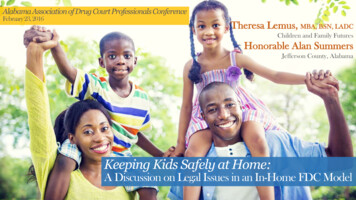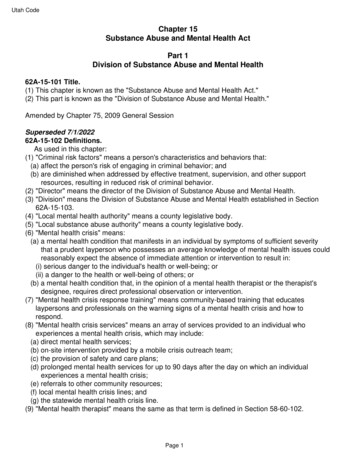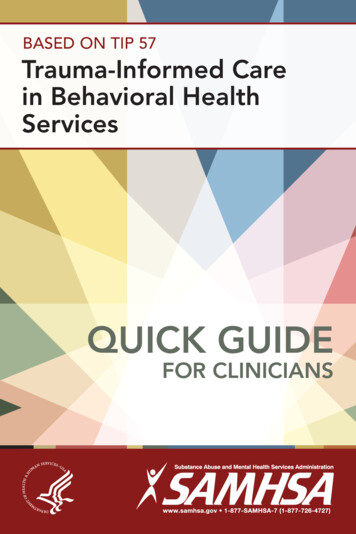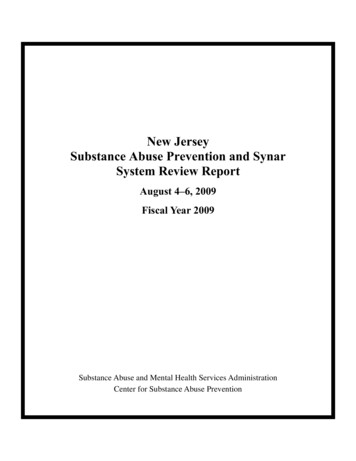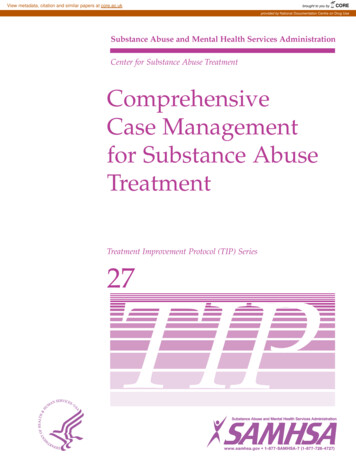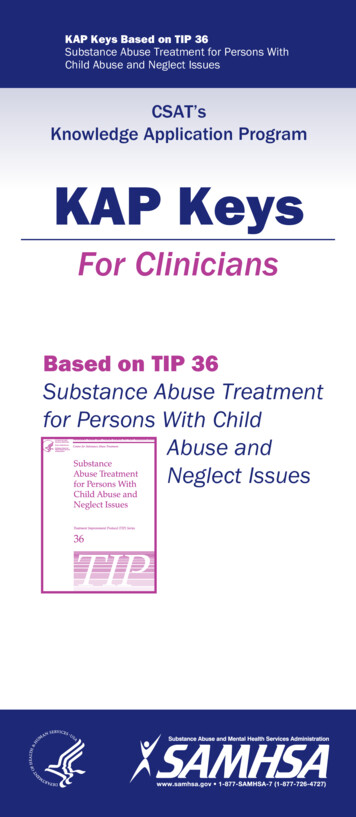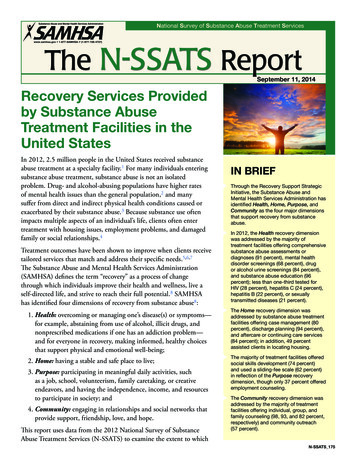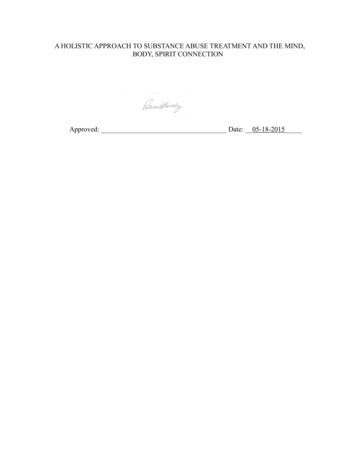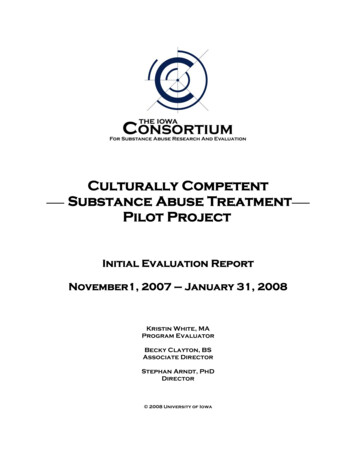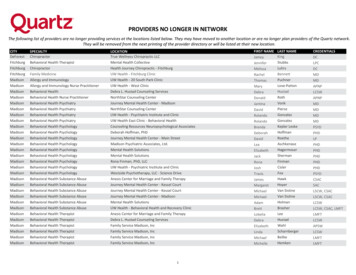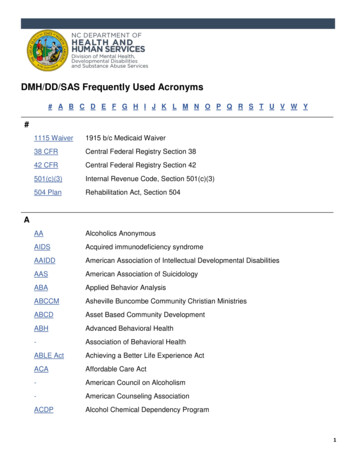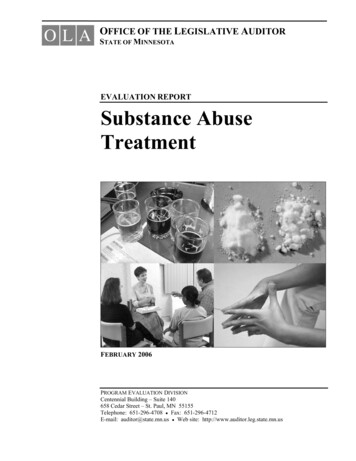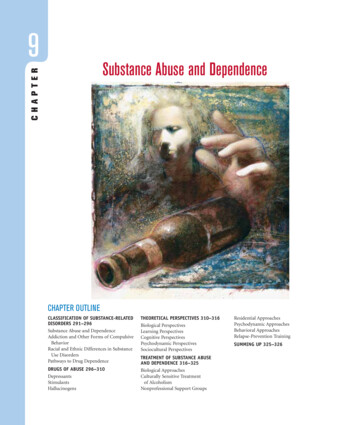
Transcription
9CHAPTERSubstance Abuse and DependenceCHAPTER OUTLINECLASSIFICATION OF SUBSTANCE-RELATEDDISORDERS 291–296Substance Abuse and DependenceAddiction and Other Forms of CompulsiveBehaviorRacial and Ethnic Differences in SubstanceUse DisordersPathways to Drug DependenceDRUGS OF ABUSE ICAL PERSPECTIVES 310–316Biological PerspectivesLearning PerspectivesCognitive PerspectivesPsychodynamic PerspectivesSociocultural PerspectivesTREATMENT OF SUBSTANCE ABUSEAND DEPENDENCE 316–325Biological ApproachesCulturally Sensitive Treatmentof AlcoholismNonprofessional Support GroupsResidential ApproachesPsychodynamic ApproachesBehavioral ApproachesRelapse-Prevention TrainingSUMMING UP 325–326
T R U T H or F I C T I O N“Nothing and Nobody Comes BeforeMy Coke”She had just caught me with cocaine again after I had managed to convince her thatI hadn’t used in over a month. Of course I had been tooting (snorting) almost everyday, but I had managed to cover my tracks a little better than usual. So she said tome that I was going to have to make a choice—either cocaine or her. Before shefinished the sentence, I knew what was coming, so I told her to think carefully aboutwhat she was going to say. It was clear to me that there wasn’t a choice. I love mywife, but I’m not going to choose anything over cocaine. It’s sick, but that’s whatthings have come to. Nothing and nobody comes before my coke.—From Weiss & Mirin, 1987, p. 55THESE COMMENTS FROM EUGENE, A 41-YEAR-OLD ARCHITECT, UNDERSCORE THE POWERFULeffects that drugs like cocaine can have on people’s lives. Our society is flooded withpsychoactive substances that alter the mood and twist perceptions—substances thatlift you up, calm you down, and turn you upside down. Many young people start usingthese substances because of peer pressure or because their parents and other authorityfigures tell them not to. For Eugene, as for many others who become addicted to drugs,the pursuit and use of drugs takes center stage in their lives and becomes even moreimportant than family, work, or their own welfare.In this chapter we examine the physiological and psychological effects of the majorclasses of drugs. We explore how mental health professionals classify substance-relateddisorders and where we draw the line between use and abuse. We then examine contemporary understandings of the origins of these disorders and how mental healthprofessionals help people who struggle to combat them.T F Heroin accounts for more deathsthan any other drug. (p. 291)T F You cannot be psychologicallydependent on a drug without also beingphysically dependent on it. (p. 295)T F More teenagers and young adults diefrom alcohol-related motor vehicle accidentsthan from any other cause. (p. 297)T F It is safe to let someone who haspassed out from drinking just “sleep it off.”(p. 301)T F Even moderate use of alcoholincreases the risk of heart attacks. (p. 303)T F Coca-Cola originally containedcocaine. (p. 306)T F Breast cancer is the leading cause ofcancer deaths among U.S. women. (p. 307)T F People who can “hold their liquor”better than most stand a lower risk ofbecoming problem drinkers. (p. 312)T F A widely used treatment for heroinaddiction involves substituting anotheraddictive drug. (p. 318)CLASSIFICATION OF SUBSTANCE-RELATED DISORDERSUnder certain conditions, the use of substances that affect mood and behavior is normal,at least as gauged by statistical frequency and social standards. It is normal to start theday with caffeine in the form of coffee or tea, to take wine or coffee with meals, to meetfriends for a drink after work, and to end the day with a nightcap. Many of us take prescription drugs that calm us down or ease our pain. Flooding the bloodstream withnicotine by means of smoking is normal in the sense that about 1 in 5 Americans do it.However, some psychoactive substances, such as cocaine, marijuana, and heroin, are illegal and are used illicitly. Others, such as antianxiety drugs (such as Valium and Xanax)and amphetamines (such as Ritalin), are available by prescription for legitimate medicaluses. Still others, such as tobacco (which contains nicotine, a mild stimulant) and alcohol (a depressant), are available without prescription, or over-the-counter. Ironically, themost widely and easily accessible substances—tobacco and alcohol—cause more deathsthrough sickness and accidents than all illicit drugs combined.The classification of substance-related disorders in the DSM system is not based onwhether a drug is legal or not, but rather on how drug use impairs the person’s physiological and psychological functioning. The DSM-IV classifies substance-related disordersinto two major categories: substance use disorders and substance-induced disorders.Substance-induced disorders are disorders induced by using psychoactive substances,such as intoxication, withdrawal syndromes, mood disorders, delirium, dementia, amnesia, psychotic disorders, anxiety disorders, sexual dysfunctions, and sleep disorders.Different substances have different effects, so some of these disorders may be induced byone, a few, or nearly all substances. Let us consider the example of intoxication.T R U T H or F I C T I O NHeroin accounts for more deaths than any otherdrug. FALSE. Two legally available substances,alcohol and tobacco, cause far more deaths.substance-induced disorders Disorders,such as intoxication, that can be induced byusing psychoactive substances.291
292Chapter 9Two of the many faces of alcohol use—and abuse. Alcohol is our most widely used—andabused—drug. Many people use alcohol to celebrate achievements and happy occasions, as inthe photograph on the left. Unfortunately, like the man in the photograph on the right, somepeople use alcohol to drown their sorrows, which may only compound their problems. Whereexactly does substance use end and abuse begin? According to the DSM, use becomes abusewhen it leads to damaging consequences.intoxication A state of drunkenness.substance use disorders Disorderschararacterized by maladaptive use ofpsychoactive substances (e.g., substancedependence).Substance intoxication refers to a state of drunkenness or being “high.” This effectlargely reflects the chemical actions of the psychoactive substances. The particular features of intoxication depend on which drug is ingested, the dose, the user’s biologicalreactivity, and—to some degree—the user’s expectations. Signs of intoxication ofteninclude confusion, belligerence, impaired judgment, inattention, and impaired motorand spatial skills. Extreme intoxication from use of alcohol, cocaine, opioids, (narcotics) and PCP can even result in death (yes, you can die from alcohol overdoses),either because of the substance’s biochemical effects or because of behavior patterns—such as suicide—that are connected with psychological pain or impaired judgmentbrought on by use of the drug.Substance use disorders are patterns of maladaptive use of psychoactive substances. These disorders, which include substance abuse and substance dependence, arethe major focus of our study.Substance Abuse and Dependencesubstance abuse The continued use of apsychoactive drug despite the knowledgethat it is causing a social, occupational,psychological, or physical problem.substance dependence Impaired controlover the use of a psychoactive substance; oftencharacterized by physiological dependence.Where does substance use end and abuse begin? According to the DSM, substanceabuse is a pattern of recurrent use that leads to damaging consequences. Damagingconsequences may involve failure to meet one’s major role responsibilities (e.g., as student, worker, or parent), putting oneself in situations where substance use is physicallydangerous (e.g., mixing driving and substance use), encountering repeated problemswith the law arising from substance use (e.g., multiple arrests for substance-relatedbehavior), or having recurring social or interpersonal problems because of substanceuse (e.g., repeatedly getting into fights when drinking).When people repeatedly miss school or work because they are drunk or “sleeping itoff,” their behavior may fit the definition of substance abuse. A single incident of excessive drinking at a friend’s wedding would not qualify. Nor would regular consumptionof low to moderate amounts of alcohol be considered abusive so long as it is not connected with any impairment in functioning. Neither the amount nor the type of drugingested, nor whether the drug is illicit, is the key to defining substance abuse according to the DSM. Rather, the determining feature of substance abuse is whether a pattern of drug-using behavior becomes repeatedly linked to damaging consequences.Substance abuse may continue for a long period of time or progress to substancedependence, a more severe disorder associated with physiological signs of dependence(tolerance or withdrawal syndrome) or compulsive use of a substance. People who
Substance Abuse and Dependence293TABLE 9.1Diagnostic Features of Substance DependenceSubstance dependence is defined as a maladaptive pattern of use that results in significantimpairment or distress, as shown by the following features occurring within the same year:1. Tolerance for the substance, as shown by eithera. the need for increased amounts of the substance to achieve the desired effect orintoxication, orb. marked reduction in the effects of continuing to ingest the same amounts.2. Withdrawal symptoms, as shown by eithera. the withdrawal syndrome that is considered characteristic for the substance, orb. the taking of the same substance (or a closely related substance, as when methadone issubstituted for heroin) to relieve or to prevent withdrawal symptoms.3. Taking larger amounts of the substance or for longer periods of time than the individualintended (e.g., person had desired to take only one drink, but after taking the first,continues drinking until severely intoxicated).4. Persistent desire to cut down or control intake of substance or lack of success in trying toexercise self-control.5. Spending a good deal of time in activities directed toward obtaining the substance(e.g., visiting several physicians to obtain prescriptions or engaging in theft), in actuallyingesting the substance, or in recovering from its use. In severe cases, the individual’sdaily life revolves around substance use.6. The individual has reduced or given up important social, occupational, or recreationalactivities due to substance use (e.g., person withdraws from family events in order toindulge in drug use).7. Substance use is continued despite evidence of persistent or recurrent psychological orphysical problems either caused or exacerbated by its use (e.g., repeated arrests for drivingwhile intoxicated).Note: Not all of these features need be present for a diagnosis to be made.Source: Adapted from the DSM-IV-TR (APA, 2000).become compulsive users lack control over their drug use. They may be aware of howtheir drug use is disrupting their lives or damaging their health, but feel helpless orpowerless to stop using drugs, even though they may want to. By the time they becomedependent on a given drug, they’ve given over much of their lives to obtaining andusing it. The cocaine user whose words opened this chapter would certainly fit this definition. The diagnostic features of substance dependence are listed in Table 9.1.Repeated use of a substance may alter the body’s physiological reactions, leading tothe development of tolerance or a physical withdrawal syndrome (see Table 9.1).Tolerance is a state of physical habituation to a drug, resulting from frequent use, suchthat higher doses are needed to achieve the same effect. A withdrawal syndrome (alsocalled an abstinence syndrome) is a cluster of symptoms that occur when a dependentperson abruptly stops using a particular substance following heavy, prolonged use.People who experience a withdrawal syndrome often return to using the substance torelieve the discomfort associated with withdrawal, which thus serves to maintain theaddictive pattern. Withdrawal symptoms vary with the particular type of drug. Withalcohol dependence, typical withdrawal symptoms include dryness in the mouth,nausea or vomiting, weakness, increased heart rate, anxiety, depression, headaches,insomnia, elevated blood pressure, and fleeting hallucinations.In some cases of chronic alcoholism, withdrawal produces a state of delirium tremens,or DTs. DTs are usually limited to chronic, heavy users of alcohol who dramatically lowertheir intake of alcohol after many years of heavy drinking. DTs involve intense autonomichyperactivity (profuse sweating and tachycardia) and delirium—a state of mental confusion characterized by incoherent speech, disorientation, and extreme restlessness.Terrifying hallucinations—frequently of creepy, crawling animals—may also be present.Substances that may lead to withdrawal syndromes include—in addition toalcohol—opioids, cocaine, amphetamines, sedatives and barbiturates, nicotine, andtolerance Physical habituation to a drugsuch that with frequent use, higher doses areneeded to achieve the same effects.withdrawal syndrome A characteristiccluster of symptoms following the suddenreduction or cessation of use of a psychoactivesubstance after physiological dependence hasdeveloped.
294Chapter 9FIGURE 9.1 Lifetime prevalence of drugdependence disorder by type of illicit drug.Drug dependence disorders involving illicitdrugs affect nearly 3 in 100 adults in theUnited States. Marijuana (cannabis) dependence is the most common type.Source: Conway et al., 2006.Percentage with Drug juanaAny DrugDependenceantianxiety agents (minor tranquilizers). Marijuana and hallucinogens such as LSD arenot recognized as producing a withdrawal syndrome, because abrupt withdrawal fromthese substances does not produce clinically significant withdrawal effects (APA, 2000).Substance dependence is often, but not always, associated with the development ofphysiological dependence. It sometimes involves a pattern of compulsive use withoutphysiological or chemical dependence. For example, people may become compulsiveusers of marijuana, especially when they rely on the drug to help them cope with thestresses of daily life. Yet they may not require larger amounts of the substance to get“high” or experience distressing withdrawal symptoms when they cease using it. In mostcases, however, substance dependence and physiological features of dependence occurtogether. Despite the fact that the DSM considers substance abuse and dependence tobe distinct diagnostic categories, the borderline between the two is not always clear.Unfortunately, substance abuse and dependence disorders are common problems inour society (Adelson, 2006). An estimated 10.3% of adults in the United States developdrug (substance) use disorders on an illicit drug at some point in their lives, with about7.7% developing a drug abuse disorder and about 2.5% developing a drug dependencedisorder (Compton et al., 2005). About 8% of adult Americans develop alcohol abuseor dependence disorders (Lemonick, 2007). People with one drug use disorder, such asalcohol dependence disorder, often present with another, such as cocaine dependencedisorder (Stinson et al., 2005). In Figure 9.1 we see the percentages of U.S. adults whodevelop drug dependence disorders on various types of illicit drugs.Addiction and Other Forms of Compulsive Behavioraddiction Impaired control over the useof a chemical substance, accompanied byphysiological dependence.physiological dependence A condition inwhich the drug user’s body comes to dependon a steady supply of the substance.The DSM uses the terms substance abuse and substance dependence as categories of substance use disorders. It does not use the term addiction to describe these problems. Yet theconcept of addiction is widespread among professionals and laypeople alike. Even someleading professionals believe the word “addiction” should replace the word “dependence” inthe diagnostic manual (O’Brien, Volkow, & Li, 2006). But what does the term “addiction”mean? Before we proceed to discuss drugs of abuse, let us define the terms we will be using.We lack any universally accepted definition of addiction. For our purposes, wedefine addiction as compulsive use of a drug accompanied by signs of physiologicaldependence. People become compulsive users when they have impaired control overtheir use of a drug. In effect, they feel compelled to continue using the drug despite thenegative consequences that continued use of the drug entails. By physiologicaldependence, we mean that a person’s body has changed as a result of the regular useof a psychoactive drug in such a way that it comes to depend on having a steady supplyof the substance. The major signs of physiological dependence are the development oftolerance and a withdrawal syndrome.
Substance Abuse and DependencePeople can also develop psychological dependence on a drug without becomingphysiologically or chemically dependent. These individuals come to compulsively usea drug to meet psychological needs. We can think of someone who compulsively usesmarijuana to cope with daily stress, but is not physiologically dependent on the drug.On the other hand, a person may become physiologically dependent on a drug but notbecome a compulsive user. For example, people recuperating from surgery are oftengiven narcotics derived from opium as painkillers. Some develop signs of physiological dependence, such as tolerance and a withdrawal syndrome, but do not developimpaired control over the use of these drugs.Other forms of compulsive behavior, such as compulsive gambling, shopping, oreven Internet use, can be likened to forms of nonchemical addiction. Whether we labelsuch behavioral patterns as addictions depends on how we define the concept of addiction (see Chapter 13 for a discussion of compulsive gambling). In this chapter, wefocus on chemical forms of dependence.Racial and Ethnic Differences in Substance Use DisordersDespite the popular stereotype that drug dependence is more frequent among ethnicminorities, this belief is not supported by evidence. To the contrary, African Americans andLatinos have comparable or even lower rates of substance use disorders than do EuropeanAmericans (non-Hispanic Whites) (Breslau et al., 2005; Compton et al., 2005). Moreover,African American adolescents are much less likely than European American adolescents todevelop substance abuse or dependence problems (Kilpatrick et al., 2000). In a later sectionwe shall examine evidence on racial/ethnic group differences in alcohol use and abuse.Pathways to Drug DependenceAlthough the progression to substance dependence varies from person to person,one common pathway involves a progression through the following stages (Weiss &Mirin, 1987):1. Experimentation. During the stage of experimentation, or occasional use, thedrug temporarily makes users feel good, even euphoric. Users feel in control andbelieve they can stop at any time.2. Routine use. During the next stage, a period of routine use, people begin to structure their lives around the pursuit and use of drugs. Denial plays a major role atthis stage, as users mask the negative consequences of their behavior to themselvesand others. Values change. What had formerly been important, such as family andwork, comes to matter less than the drugs.The following clinical interview illustrates how denial can mask reality. This48-year-old executive was brought for a consultation by his wife. She complainedhis once-successful business was jeopardized by his erratic behavior, he wasgrouchy and moody, and he had spent 7,000 in the previous month on cocaine.CLINICIAN: Have you missed many days at work recently?EXECUTIVE: Yes, but I can afford to, since I own the business. Nobody checks up on me.CLINICIAN: It sounds like that’s precisely the problem. When you don’t go to work,the company stays open, but it doesn’t do very well.EXECUTIVE: My employees are well trained. They can run the company without me.CLINICIAN: But that’s not happening.EXECUTIVE: Then there’s something wrong with them. I’ll have to look into it.CLINICIAN: It sounds as if there’s something wrong with you, but you don’t want tolook into it.EXECUTIVE: Now you’re on my case. I don’t know why you listen to everything mywife says.CLINICIAN: How many days of work did you miss in the last two months?EXECUTIVE: A couple.CLINICIAN: Are you saying that you missed only two days of work?EXECUTIVE: Maybe a few.295psychological dependence Compulsiveuse of a substance to meet a psychologicalneed.T R U T H or F I C T I O NYou cannot be psychologically dependent on adrug without also being physically dependent on it. FALSE. You can become psychologicallydependent on a drug without developing a physiological dependence.
296Chapter 9CLINICIAN: Only three or four days?EXECUTIVE: Maybe a little more.CLINICIAN: Ten? Fifteen?EXECUTIVE: Fifteen.CLINICIAN: All because of cocaine?EXECUTIVE: No.CLINICIAN: How many were because of cocaine?EXECUTIVE: Less than fifteen.CLINICIAN: Fourteen? Thirteen?EXECUTIVE: Maybe thirteen.CLINICIAN: So you missed thirteen days of work in the last two months because ofcocaine. That’s almost two days a week.EXECUTIVE: That sounds like a lot but it’s no big deal. Like I say, the company canrun itself.CLINICIAN: How long have you been using cocaine?EXECUTIVE: About three years.CLINICIAN: Did you ever use drugs or alcohol before that in any kind of quantity?EXECUTIVE: No.CLINICIAN: Then let’s think back five years. Five years ago, if you had imaginedyourself missing over a third of your workdays because of a drug, and if you hadimagined yourself spending the equivalent of 84,000 a year on that same drug,and if you saw your once-successful business collapsing all around you, wouldn’tyou have thought that that was indicative of a pretty serious problem?EXECUTIVE: Yes, I would have.CLINICIAN: So what’s different now?EXECUTIVE: I guess I just don’t want to think about it.—From Weiss & Mirin, 1987, pp. 79–80As routine drug use continues, problems mount. Users devote more resourcesto drugs. They ravage family bank accounts, seek “temporary” loans from friendsand family for trumped-up reasons, and sell family heirlooms and jewelry for afraction of their value. Lying and manipulation become a way of life to cover upthe drug use. The husband sells the TV set and forces the front door open to makeit look like a burglary. The wife claims to have been robbed at knifepoint to explainthe disappearance of a gold chain or engagement ring. Family relationships becomestrained as the mask of denial shatters and the consequences of drug abuse becomeapparent: days lost from work, unexplained absences from home, rapid moodshifts, depletion of family finances, failure to pay bills, stealing from family members, and missing family gatherings or children’s birthday parties.3. Addiction or dependence. Routine use becomes addiction or dependence whenusers feel powerless to resist drugs, either because they want to experience theireffects or to avoid the consequences of withdrawal. Little or nothing else mattersat this stage, as we saw in the case of Eugene with which we opened the chapter.Now let us examine the effects of different types of drugs of abuse and the consequences associated with their use and abuse.DRUGS OF ABUSEDrugs of abuse are generally classified within three major groupings: (a) depressants,such as alcohol and opioids; (b) stimulants, such as amphetamines and cocaine; and(c) hallucinogens.Depressantsdepressant A drug that lowers the level ofactivity of the central nervous system.A depressant is a drug that slows down or curbs the activity of the central nervoussystem. It reduces feelings of tension and anxiety, slows movement, and impairs cognitive processes. In high doses, depressants can arrest vital functions and cause death.
Substance Abuse and Dependence297The most widely used depressant, alcohol, can cause death when taken in largeamounts because of its depressant effects on breathing. Other effects are specific to theparticular kind of depressant. For example, some depressants, such as heroin, producea “rush” of pleasure. Here let us consider several major types of depressants.Alcohol Alcohol is the most widely abused substance in the United States and worldwide You might not think of alcohol as a drug, perhaps because it is so common, or perhaps because it is ingested by drinking rather than by smoking or injection. But alcoholic beverages—such as wine, beer, and hard liquor—contain a depressant drug calledethyl alcohol (or ethanol). The concentration of the drug varies with the type of beverage (wine and beer have less pure alcohol per ounce than distilled spirits such as rye,gin, or vodka). Alcohol is classified as a depressant because it has biochemical effectssimilar to those of a class of antianxiety agents or minor tranquilizers, the benzodiazepines, which includes the well-known drugs diazepam (Valium) and chlordiazepoxide(Librium). We can think of alcohol as an over-the-counter tranquilizer.Most American adults drink alcohol at least occasionally and do so in moderation.But many people develop significant problems with alcohol. Many lay and professionalpeople use the terms alcoholism and alcohol dependence interchangeably, as we will.We use either term to refer to a pattern of impaired control over the use of alcohol insomeone who has become physiologically dependent on the drug. An estimated eightmillion U.S. adults suffer from alcholism (Kranzler, 2006).The most widely held view of alcoholism is the disease model, the belief that alcoholism is a medical illness or disease. From this perspective, once a person with alcoholism takes a drink, the biochemical effects of the drug on the brain create an irresistiblephysical craving for more. The disease model holds that alcoholism is a chronic, permanent condition. The peer-support group Alcoholics Anonymous (AA) subscribes to thisview, which is expressed in their slogan, “Once an alcoholic, always an alcoholic.” AAviews people suffering from alcoholism as either drinking or “recovering,” never “cured.”However, later in this chapter we shall see that some professionals, including the psychologists Linda and Mark Sobell, adopt a different perspective. Their research showsthat some alcohol abusers can learn skills of controlled social drinking that enables themto drink moderately without “falling off the wagon.” The contention that some peoplewith alcohol problems can learn to drink moderately remains controversial.The personal and social costs of alcoholism exceed those of all illicit drugs combined. Alcohol abuse is connected with lower productivity, loss of jobs, and downwardmovement in socioeconomic status. Alcohol plays a role in many violent crimes,including assaults and homicides, and more than 180,000 rapes and sexual attacksannually in the United States (Bartholow & Heinz, 2006; Buddie & Testa, 2005;O’Farrell, Fals-Stewart, & Murphy, 2005). About 1 in 3 suicides in this country andabout the same proportion of deaths due to unintentional injury (such as from motorvehicle accidents) are linked to alcohol use (Dougherty et al., 2004; Sher, 2005;Shneidman, 2005). More teenagers and young adults die from alcohol-related motorvehicle accidents than from any other cause. Despite increased awareness about therisks of drinking and driving, fatal alcohol-related motor vehicle accidents are on therise (O’Donnell, 2003). All told, an estimated 100,000 people in the United States diefrom alcohol-related causes each year, mostly from motor vehicle crashes and alcoholrelated diseases (Society for Neuroscience, 2005b).Despite the popular image of the person who develops alcoholism as a skid-rowdrunk, only a small minority of people with alcoholism fit the stereotype. The greatmajority of people with alcoholism are quite ordinary—your neighbors, coworkers,friends, and members of your own family. They are found in all walks of life and everysocial and economic class. Many have families, hold good jobs, and live fairly comfortably. Yet alcoholism can have just as devastating an effect on the well-to-do as on theindigent, leading to wrecked careers and marriages, to motor vehicle and other accidents, and to severe, life-threatening physical disorders, as well as exacting an enormous emotional toll. Alcoholism is also linked to higher levels of domestic violenceand greater risk of divorce (Marshal, 2003).alcoholism An alcohol dependence disorderor addiction that results in serious personal,social, occupational, or health problems.T R U T H or F I C T I O NMore teenagers and young adults die from alcoholrelated motor vehicle accidents than from anyother cause. TRUE. Alcohol-related motor vehicle accidentsare the leading cause of death among teenagersand young adults.
298Chapter 9QUESTIONNAIREAre You Hooked?Are you dependent on alcohol? If you shake and shiver andundergo the tortures of the darned (our editor insisted onchanging this word to maintain the decorum of a textbook)when you go without a drink for a while, the answer is clearenough. However, sometimes the clues are more subtle.The following questions, adapted from the National Council onAlcoholism’s self-test, can shed some light on the question. Simply place acheck mark in the “yes” or “no” column for each item. Then check the keyat the end of the chapter.YES1. Do you sometimes go on drinking binges?2. Do you tend to keep away from your familyor friends when you are drinking?3. Do you become irritated when your familyor friends talk about your drinking?4. Do you feel guilty now and then aboutyour drinking?5. Do you often regret the things you havesaid or done when you have been drinking?6. Do you find that you fail to keep thepromise
291 or T F Heroin accounts for more deaths than any other drug. (p. 291) T F You cannot be psychologically dependent on a drug without also being physically dependent on it. (p. 295) T F More teenagers and young adults die from alcohol-related motor vehicle accidents
